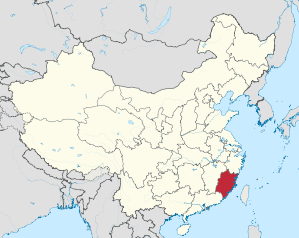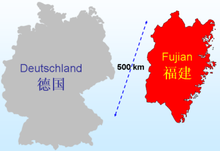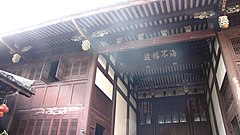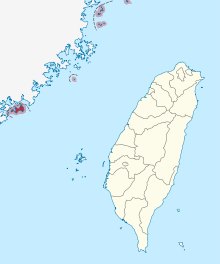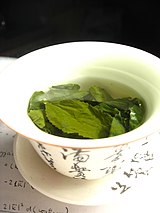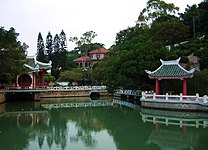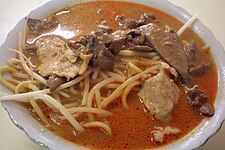Fujian
| Abbreviation : 閩 / 闽 ( Pinyin : Mǐn) | |
| capital city | Fuzhou |
|
surface - Total |
Rank 23 out of 33 121,400 km² |
|
population
- Total 2020 |
Rank 15 out of 33
41,540,086 inhabitants |
| Management type | province |
| governor | Tang Dengjie |
| ISO-3166-2 code | CN-FJ |
| District level | 9 cities |
| District level | 43 counties, 29 city districts, 13 cities |
| Community level | 600 large parishes, 311 parishes, 173 street districts, 19 nationality parishes |
Fujian ( Chinese 福建省, Pinyin Fújiàn Shěng , obsolete transcription of the Fukien Universal Postal Union , in the local Min-Nan language Hokkien ) is a province in the southeast of the People's Republic of China .
The name for this province was made up of the names of the two cities of Fuzhou and Jian'ou during the Tang Dynasty .
The island groups Kinmen (金門 / 金门, Jīnmén ) and Matsu (馬祖 列島 / 马祖 列岛, Mǎzǔ Lièdǎo ), which are geographically part of Fujian and are located just off the coast, are controlled by the Republic of China and administered there as "Fujian Province". The province thus exists twice as an administrative unit: within the People's Republic of China , which controls most of Fujian, and within the internationally not generally recognized Republic of China, where Fujian is one of two remaining provinces (besides Taiwan ).
geography
The province is located on the southeast coast of China. With its area of 121,400 square kilometers, the province is somewhat larger than the former GDR, but has twice the population. It borders the provinces of Zhejiang in the north, Jiangxi in the west and Guangdong in the southwest. To the east and south are the East China Sea , South China Sea, and the Taiwan Strait . Fujian has strong cultural ties with the island of Taiwan on the other side of the Taiwan Strait. Several small cross-strait islands are part of Fujian, while the Matsu and Quemoy are controlled by the Republic of China .
Fujian is geographically isolated from the rest of mainland China by several forested mountain ranges, these mountain ranges running parallel to the coast. Its height increases towards the hinterland, on the border with Jiangxi lies the Wuyi Mountains , which are up to 2,100 m above sea level. d. M. is the highest point in the province. In total, mountainous land takes up around 90% of the surface. The coast is very rich in bays and islands, there are only a few flat areas between the mountains and the coast. The relief is described by the inhabitants of Fujian with the proverb "八 山 一 水 一 分 田 - bashan yishui yi fen tian", ie eight parts of mountains, one part of water and one part of field.
The main settlement area of Fujian with a population density of sometimes over 1000 inhabitants per square kilometer is located between the two delta regions of the Min River and the Jiulong River . Larger cities are Fuzhou , Putian , Quanzhou , Xiamen , Zhangzhou (from north to south on the coast) as well as Nanping , Sanming and Longyan (in the hinterland on a parallel to the coast).
Waters
Due to the topography of the province, almost all rivers originate in the province and also flow into the sea on the coast of Fujian. The Wuyi Mountains form the watershed between Fujian and Jiangxi , and the Donggong Mountains form the watershed between Fujian and Zhejiang . The longest river, the Min River , gave the province its short name Min . Other important rivers are the Jiulong River , Ting River , Jin River , Jiao Xi , Ao River , Huotong Xi , Mulan River , Zhaoandong Xi , Zhang River , Qiulu River, and Long River . All of them have a catchment area larger than 500 km². A large number of smaller watercourses have their source in the mountains in the center of the province and flow from there directly into the sea. The largest four rivers drain three-quarters of Fujian's territory. Due to the high rainfall climate, the Fujian's rivers discharge 116.8 billion cubic meters of water into the sea every year. The largest river, the Min River, accounts for almost half of this.
Most of the water is taken up by the rivers of the province in their upper and middle courses. Since they arise in the rainy mountains, they absorb a lot of water here, which leads to frequent flooding in the lower reaches. The provincial average annual runoff is 962 mm, depending on the amount of rain it is between 500 and 1400 millimeters. Within China, only Taiwan and Guangdong have more annual runoff.
The coast of Fujian Province would be 530 kilometers long in a straight line. Due to the numerous bays and peninsulas, the coast is extended many times over to around 3,080 kilometers.
climate
The province of Fujian is characterized by a warm, humid and subtropical monsoon climate . The average annual temperature is between 17 and 21 ° C. The July temperature on the coast is on average 30 ° C, the January temperature 10 ° C; these values are lower in the mountains. The average rainfall is between 1,100 and 2,000 mm (1,670 mm in the provincial average), with the majority (80–85%) of the rain falling between May and September. The western mountainous region receives more rainfall than the coastal regions, and Fujian is one of the regions with the most rainfall in mainland China. Typhoons occur annually in summer and autumn and require extensive evacuations, as in September 2005, when 760,000 people had to be brought to safety from Typhoon Talim .
Administrative structure
People's Republic of China
The province of Fujian is divided into nine prefecture-level cities (see there for detailed information):
| map | Surname | Administrative headquarters | Hanzi 1 , Hanyu Pinyin | Population (as of end of 2017) | |
|---|---|---|---|---|---|
| - sub-provincial town - | |||||
| Xiamen | Siming | 厦门 市, Xiàmén Shì | 4,010,000 | ||
| - District-free city - | |||||
| Fuzhou | Gulou | 福州市, Fuzhōu Shì | 7,660,000 | ||
| Longyan | Xinluo | 龙岩 市, Lóngyán Shì | 2,640,000 | ||
| Nanping | Yanping | 南平 市, Nánpíng Shì | 2,680,000 | ||
| Ningde | Jiaocheng | 宁德 市, Níngdé Shì | 2,900,000 | ||
| Putian | Chengxiang | 莆田 市, Pútián Shì | 2,900,000 | ||
| Quanzhou | Fengze | 泉州市, Quánzhōu Shì | 8,650,000 | ||
| Sanming | Sanyuan | 三明 市, Sānmíng Shì | 2,570,000 | ||
| Zhangzhou | Xiangcheng | 漳州 市, Zhāngzhōu Shì | 5,100,000 | ||
Republic of China
Fujian Province is made up of two counties: Kinmen and Lienchiang . The total area of the islands is 182.66 km². 71,000 people live on the islands (as of 2001).
| Surname | Kinmen 2 | Lienchiang 2 |
|---|---|---|
| Chinese | 金門 縣 | 連江縣 |
| map |
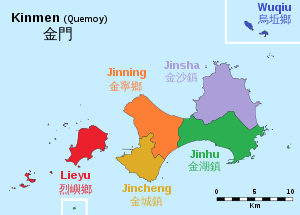
|
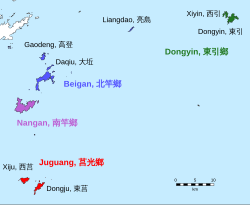
|
| Islands | 15 islands | 36 islands |
|
|
|
| Administrative division | 6 large municipalities | 4 large municipalities |
story
Early history
Archaeological finds show that northern Fujian entered the Neolithic Age about 8,000 years ago . This is proven by the finds from Keqiutou (殼 丘 頭 / 壳 丘 头, Pingtan Island 70 km southeast of Fuzhou ), which were dated to an age between 7,450 and 5,590 years. These include tools made of stones, bones, shells and jade; Discovered needles and spinning wheels prove, for example, that the residents were already masters of the art of weaving. Semi-subterranean circular buildings have been found in Tanshishan (曇 石山 / 昙 石山), and the finds in Huangtulun (黃土 崙 / 黄土 仑, dated around 3,300 years ago and also near Fuzhou) indicate the entry into the Bronze Age .
The finds also show, however, that the indigenous people of the province, Austronesians , who probably immigrated from Southeast Asia by sea, were almost unfamiliar with agriculture and subsisted on fishing. These people with big eyes, flat noses and tattooed bodies mainly populated the regions along the Min River . The remaining, densely forested territory was very sparsely populated. Only during the Qin and Han dynasties was the area explored by the Chinese and the first officials were sent to set up administrative structures. From the Han Dynasty onwards, the natives were displaced northwards, north of what is now Shanghai .

However, the area could not be incorporated into Chinese ancestral territory immediately, because a rival empire emerged in what is now Fujian during the Warring States' era . The Yue tribe had the empire in the 3rd century BC. Founded when their ancestral territory was conquered by the Kingdom of Chu . Under the Qin dynasty , the kingdom was formally incorporated into the Qin area. When the short-lived Qin dynasty collapsed and civil war raged, King Wuzhu of Minyue supported the warlord Liu Bang in the fight against Xiang Yu . Liu Bang later established the Han Dynasty with Wuzhu's help , and in 202 BC. Minyue got the status of a formally independent, but tributary kingdom back. Minyue was allowed to build fortresses (for example in Fuzhou and the Wuyi Mountains ) and to expand their territory beyond that of the present-day province. Minyue then included, in addition to today's Fujian, eastern Guangdong , southern Zhejiang and eastern Jiangxi . Culturally, Minyue was Sinized , and its culture was a mixture of Austronesian and Han elements.
After the death of King Wuzhu, the kingdom maintained the military tradition and repeatedly attacked its neighbors. In 111 BC The Han emperor decided to remove the potential danger and attacked the kingdom simultaneously on land and sea, thus wiping out Minyue. In order to avoid great destruction, the rulers in Fuzhou gave up the fight early, the Minyue Empire thus came to a very abrupt end. In the north of Fujian, however, there are still numerous temples that were built to worship the first kings of Fujian.
The Han dynasty collapsed in the 2nd century AD. The area of what is now Fujian was ruled by the Kingdom of Wu during the Three Kingdoms Period . It took the founder of Wu, Sun Quan , nearly twenty years to subjugate the Shan Yue (the Yue in the mountains).
In the early 4th century, after the collapse of the Western Jin Dynasty , northern China was attacked by nomads from the north and civil war raged. Thus came the first wave of immigrants to Fujian. The immigrants came mainly from three central Chinese clans, namely Lin (林), Huang (黃 / 黄), Chen (陳 / 陈), Zheng (鄭 / 郑), Zhan (詹), Qiu (邱), He (何) , and Hu (胡), the first four remaining the most important family names in modern day Fujian.
Because of the rough topography of the area, Fujian remained relatively sparsely populated, economic development lagged behind the rest of China, and only two command posts and sixteen districts were established. Similar to the other provinces in the south, Fujian served not least as a target for prisoners or dissidents. However, the process of slow integration of Fujian into the Chinese empire and the assimilation of the non-Chinese peoples began.
During the Northern and Southern Dynasties , Fujian was under the influence of the Southern Dynasties. Their rulers made great efforts to colonize the area with Han.
First flowering during the Tang to Ming dynasties
During the Tang Dynasty (618–907), Fujian was an integral part of the Chinese Empire. From this point onwards, shipping and trade are closely linked to the history of the province, while the rest of China is traditionally oriented towards the land. During the Tang and Song dynasties , China's economic heavyweight moved south, and especially after the An Lushan rebellion in the 8th century, there was massive migration from the south . The immigrants during the Five Dynasties and Ten Kingdoms were led by General Wang, who established the Min Kingdom, with Fuzhou as its capital. After Wang's death, however, the Min Kingdom was so weakened by internal fighting that it was swallowed up by the Southern Tang .
In 150 years the population of the province increased sixfold. On the one hand this brought pressure to feed the many people, on the other hand there was also enough labor for land reclamation, the creation of terraced fields and the digging of irrigation canals. In these points Fujian achieved technological leadership in China by the 10th century. The city of Fuzhou became an important port and trading city, through which tea was mainly exported.
From the 9th century onwards, Arab traders were in China, especially in Quanzhou , to do business with the Chinese. Quanzhou slowly overtook Fuzhou or Guangzhou in their handling and became what was then probably the largest port in the eastern world. During the early Ming Dynasty , Quanzhou was the starting point for Admiral Zheng He's expeditions (his first expedition started in 1405). In addition to trade and shipping, handicrafts, art and science also experienced a great boom. Fujian was one of the wealthiest areas in China. A relatively large number of high dignitaries of the Empire from the Song to Yuan dynasties came from Fujian . The period from the 11th to the 14th centuries is therefore the Golden Age of Fujian.
The decline began with a non-Chinese rebellion in Quanzhou city that was destroyed. At the same time, Japanese pirates, the Wokou , threatened the Chinese south coast, whereupon the government reacted with a restriction and later a ban on sea trade. Trade was further hampered by silting up of Quanzhou's natural harbor. The fall of the Yuan Dynasty plunged the region into chaos. Although a new sea trade ban ( Hai jin ) was lifted again in 1567, after the Chinese military and the Japanese daimyo had successfully combated piracy , trade in the region could not recover. From here on, Guangzhou , Hangzhou , Ningbo or Shanghai were more important.
The strong upswing in the region had led to a population explosion. The descent resulted in massive exodus. Fujianese subsequently settled Taiwan , the Philippines , parts of what is now Malaysia and Indonesia . The collapse of the Ming Dynasty in turn led to a large influx of migrants, which, however, did not lead to a new population explosion due to the simultaneous emigration to overseas and Guangdong . The last followers of the Ming attacked the Dutch in Taiwan under Koxinga in 1650 and drove them from there. In order to weaken the Ming government under Koxinga in Taiwan, the Qing Emperor Kangxi again imposed a 20-year sea trade ban . In 1689 this last Ming bastion was overthrown and the Qing annexed Taiwan to Fujian. During this time, the emigration from Fujian to Taiwan reached its peak; a large part of the population of today's Taiwan is descended from former migrants.
Modern
From the early 17th century onwards, Fujian became more and more a target of foreign influence. This was initially one of the reasons that the Qing once again increasingly regulated sea trade. After the defeat in the First Opium War and the Treaty of Nanking , the Chinese Empire had to open further ports to foreign influence in 1842. Among these ports were Amoy (present-day Xiamen ) and Fuzhou . Missionaries began their activities here and factories based on foreign models were opened, as a result of which these two trading centers were temporarily upgraded internationally. In Fuzhou in particular, schools and newspapers based on foreign models emerged, which formed a breeding ground for revolutionary activities. Xiamen's open port grew rapidly in importance. After the population pressure was high in Fujian but there was a shortage of labor in some British colonies, the British trader James Tait saw a business opportunity. This was the beginning of the pen trade (1847); between 1876 and 1898, 1.36 million people were exported from Xiamen to Southeast Asia . This was also the beginning of a flourishing passenger traffic between Xiamen and some distant destinations.
Taiwan became its own province for the first time in 1885. After the first Sino-Japanese War (1894–1895) and the Shimonoseki Treaty , Fujian came under strong Japanese influence, while many foreign companies (especially British) began to invest in Fujian’s first industries.
The overseas Chinese, who had come into contact with republican ideas abroad, also returned to their homeland and prepared for the overthrow of the Qing dynasty, which had already been severely weakened by numerous military defeats.
Republican period
After the Qing were overthrown in 1911, Fujian came under the rule of several warlords in quick succession. Yuan Shikai was then able to temporarily bring Fujian under his control, and Li Houji , Sun Chuanfang and Zhou Yinren became military governors of the province. However, between 1918 and 1920, Chen Jiongming held the south of the province; During these two years, ambitious reform projects were undertaken in Zhangzhou . Chen was called to Guangdong in 1920 to support Sun Yat-sen , and his administration in Zhangzhou fell into disrepair.
In 1926, as part of the northern campaign , Fujian came under the control of Chiang Kai-shek's Kuomintang , and a period of relative stability began. This was suddenly interrupted when in the winter of 1933/1934 a revolt took place under Li Jichen , Chen Mingshu and Cai Tingjie , which culminated in Fujian's declaration of independence from the central government in Nanjing . This separatist movement was brutally crushed in less than two months. During the Chinese Civil War , the Jiangxi Soviet , a base region of the communists, expanded into western Jiangxi, and the rest of the province became a staging area for the Kuomintang to fight the Soviet.
In the Second Sino-Japanese War , Fujian's coast was occupied by the Japanese army and the provincial government was forced to withdraw to Yong'an . War raged again in Fujian during the civil war between the Kuomintang and the communists.
Since the founding of the People's Republic of China
As a result of the civil war, the communists were victorious on the mainland and established the People's Republic of China , while the Kuomintang withdrew to Taiwan. The confrontation between the two powers meant that Fujian was right on the front line, which delayed their economic recovery. Until then, the province had been relatively isolated from the rest of China (in the 1960s, villages are said to have been found in the mountains whose inhabitants did not know that the Qing dynasty had been overthrown). Except for one railway line (opened in 1956), no major investments were made in Fujian. On the other hand, Fujian also got into the turmoil of the Great Leap Forward and the Cultural Revolution , which caused great damage to agriculture and nature.
Nevertheless, the strong academic tradition that had ruled since the Southern Song Dynasty continued in real socialist China. Many members of the Chinese Academy of Sciences are from Fujian.
Since China opened up to the rest of the world, the inflow of capital from Taiwan and overseas Chinese has made the coastal cities of Fujian some of the richest in China. This leads to strong immigration pressures from the overpopulated areas in central and northern China. In many cities - as in all coastal regions of China - traditional quarters and cultural heritage have to give way to inexpensive high-rise buildings.
population
With around 289 inhabitants per square kilometer, Fujian is an average densely populated province by Chinese standards. The population, however, is very unevenly distributed, with the largest part being concentrated on the relatively few levels. In terms of population growth, Fujian is slightly above average.
Over the past decade, Fujian has become a province that is growing in net population from migration due to its rapid economic development . Until the early 1990s, Fujian was an emigration region. Fujian is now losing population in the direction of the richer provinces of Guangdong , Jiangsu , Zhejiang and the sub-government city of Shanghai . It is gaining population from the poorer provinces of Sichuan , Jiangxi , Guizhou and Anhui . Among the migrants there is a high proportion of people who do not want or are not allowed to move their official residence to Fujian; these so-called non- hukou migrants make up around 6% of the population.
The urbanization rate for the year 2000 is given as 42%.
Ethnic breakdown of the population of Fujian (2000)
The 2000 census counted 34,097,947 residents of Fujian.

| Ethnicity | Hanzi 1 | resident | portion |
|---|---|---|---|
| Han | 汉族 | 33,514,147 | 98.29% |
| She | 畲族 | 375.193 | 1.10% |
| Hui | 回族 | 109,880 | 0.32% |
| Tujia | 土家族 | 29,046 | 0.09% |
| Miao | 苗族 | 22,065 | 0.06% |
| Zhuang | 壮族 | 10,818 | 0.03% |
| Manchu | 滿洲 族 | 7.094 | 0.02% |
| Mongols | 蒙古族 | 6.114 | 0.02% |
| Dong | 侗族 | 5,768 | 0.02% |
| Bouyei | 布依族 | 4,206 | 0.01% |
| Others | 其他 | 13,616 | 0.04% |
"Others" also includes over 400 Gaoshan , indigenous people of Taiwan who stayed on the mainland after the partition of China. Fujian also has a large population of Hakka (客家), the Han people who immigrated from northern China centuries ago.
Among the overseas Chinese , emigrants from Fujian ( Hokkien ) make up the second largest proportion after Guangdong . In Taiwan they even make up the majority of the population. That is why the Taiwan dialect is only considered a variant of the various Min dialects , although this is mainly controversial for political reasons. The overseas Chinese are very important for the economic development of the province, mainly because they are responsible for a very high proportion of foreign investment in Fujian. Important politicians whose ancestors came from Fujian are Lee Teng-hui in Taiwan , Lee Kuan Yew in Singapore and Corazon Aquino in the Philippines .
Culture
language
Because of its history and mountainous nature, Fujian is one of the most linguistically interesting regions in the world. Local dialects can be incomprehensible within 10 kilometers. The dialects are counted among the Min languages , including Taiwanese ; the Min languages can again be roughly divided into the northern ( Min Bei ), eastern ( Min Dong ) and southern ( Min Nan ) varieties, whereby the linguistic and cultural identity is very strong in each case. However, the official language is Putonghua (Mandarin Chinese), which is also used for communication among people from different places. While the Hakka have received their own language, the other minorities in the province, such as the She , no longer speak their own language. In the past, merchants in Fujian used pidgin English for this purpose, which is now extinct.
It is interesting that the German word “ tea ” comes from the dialect of the region around Xiamen ( Hokkien ). Most of the countries that originally purchased tea overland, however, adopted the North Chinese pronunciation cha for茶and made chai out of it . This applies above all to the Russians , the Indians , the Turks and the Arabs, but also to the Japanese and Koreans .
religion
The colorful mixture of Buddhism , Daoism and Chinese folk beliefs typical of China is widespread in Fujian . In addition, there is a fairly high number of Muslims who are descendants of the 100,000 or so Arabs who resided in Quanzhou under the Yuan Dynasty .
The traditional folk belief shows shamanistic elements, media and trance states play an important role in it.
Buddhism came to the province from the north in the time of the Western Jin Dynasty . At that time the political situation was very unstable and numerous wars raged across the region. This gave Buddhism a great popularity. Monastic settlements sprang up all over the province, especially on famous mountains. One example of this is the stone pagoda on Tabu Mountain ( 6th century ). By the 11th century, Buddhism in Fujian was in its full bloom; At that time, Fuzhou City alone had 1,500 monasteries. Significant Buddhist buildings still preserved are Hualin Si and Dayun Si in Fuzhou , Guanghua Si in Putian and the Kaiyuan Temple in Quanzhou .
In addition to Buddhist temples, there are numerous temples for local deities in Fujian, with the worship of Mazu being the most important. The most important such temple is on Meizhou Island and is dedicated to Mazu. The temple in Meizhou is the most important for the cult of Mazu; however, it was almost completely destroyed during the Cultural Revolution and is only slowly being rebuilt, with funds coming mainly from Taiwan.
architecture
The architecture of the religious buildings is mainly influenced by northern China, but to a lesser extent also by overseas. The overseas influence has not infrequently been brought with them by the Chinese returning from abroad, who built their houses in a mix of Chinese architecture with the elements of their foreign second home. If they funded the construction of temples, then these elements also flowed into the religious art of culture.
In secular architecture, the buildings that foreigners had erected are of particular interest. These can still be found today mainly on the island of Gulangyu .
Cultural fragmentation
An interesting phenomenon in Fujian is the fragmentation of the population in terms of their culture. Due to the dominance of the Han nationality, the Chinese culture is of course predominant; some peculiarities have been preserved. The Hakka , who belong to the Han, have their own language, but other nationalities ( She , Hui Chinese ) have given up their original language. While the She and the Muslims of Fujians nowadays live in the Confucian tradition, marriage customs have been preserved in Hui'an County in which the woman only leaves her parents' home and moves in with her husband when she becomes pregnant . In the same circle, traditional costumes have been handed down that are very unusual for the Han and are likely to be traced back to the influences of peoples who have meanwhile been absorbed by the Han. The forms of settlement of the Hakka in round houses are also worth mentioning -客家 土樓 / 客家 土楼, Kèjiā tǔlóu .
How this fragmentation came about has not yet been satisfactorily explained scientifically.
kitchen
Fujian has its own culinary tradition that is distinct from the rest of China. Typical of Fujian's cuisine are the processing of seafood, clear, mildly spiced soups and a religious renunciation of beef.
business
Economic development is very uneven. While the coastal cities such as the provincial capital Fuzhou or the special economic zone Xiamen are relatively prosperous and attract significant foreign investment, the mountainous hinterland is poorly developed.
In 2015, the province had a GDP of 2.60 trillion yuan (417 billion US dollars), making it eleventh among the provinces of China. The GDP per capita was 73,951 yuan (US $ 11,134 / PPP : US $ 21,293) per year (7th among the Chinese provinces). The level of prosperity in the province was thus roughly on par with Uruguay and was 137% of the Chinese average.
- Development data
- Gross domestic product (2015): 2.597 billion renminbi
- GDP per capita (2015): 73,951 renminbi
- Exports (2002): 23.5 billion US dollars
- Imports (2002): 15.1 billion US dollars
- Foreign direct investment (2002): 4.8 billion US dollars
- Agriculture: 14.1% (1985: 34.0%)
- Industry: 46.1% (1985: 36.2%)
- Services: 39.7% (1985: 29.8%)
- Inflation: 0.8%
Economic history
In the early economic history of Fujian, the Quanzhou and Zhangzhou cycles are of particular interest. Both cycles started with a boom triggered by overseas trade. In the 16th century, for example, the route between Fujian and the Philippines was one of the most important trade routes in the world; Silk and silver in particular were traded between the then Chinese Empire and the archipelago under Spanish colonial rule. The wealth gained through trade made crafts and culture flourish and attracted large numbers of immigrants from other parts of China. Both cycles came to a rather dramatic end when overseas trade came to a standstill. The lack of profits from trade resulted in food cease to be imported, famine broke out, and mass emigration from Fujian to various regions of Southeast Asia.
After the Opium Wars ended , Fuzhou and Xiamen were declared open ports. Shortly afterwards, missionaries began to settle in these two cities. Due to the Taiping Uprising , Fuzhou suddenly became an important port for the tea trade, as the routes via Guangzhou or Shanghai were impassable due to the war. The first factories were founded in 1860, such as the shipyard in Mawei and a number of textile companies. 70% of the factories were located in Fuzhou. Between 1917 and 1919 there was even an aircraft factory in Fuzhou.
Between the fall of the Qing Dynasty and the end of the civil war, Fujian's economy experienced a sharp ups and downs, depending on how unstable the political situation was.
For the period after the founding of the People's Republic of China, two phases can be clearly separated from one another: a period of stagnation until 1978 and a period of dynamic growth from 1978 until now.
There are three main reasons given for the stagnation between 1949 and 1978:
- The possibility of an armed conflict between Taiwan and the People's Republic. For this reason, no strategically important industries were settled in the coastal region of Fujians.
- The Third Front policy , which aimed to industrialize the Chinese hinterland. Fujian was largely left out, which is why the provincial government operated a small third-front policy and established heavy industry in the region around Sanming and Yong'an . The most important products of these companies were steel, copper, chemical products, cement and machines. The resident companies were usually businesses that offered their employees everything they needed to live. As a result, the settlement of industry brought almost no economic impetus to the region.
- The self-sufficiency policy and the ban on tradable goods. The economic strategy was designed to supply the population with basic food. Everything that could have been exported was no longer intended. The consequences hit Fujian, which traditionally lived from trade and imported food with the profits made in trade, particularly hard.
As a result, Fujian was China's poorest coastal province in 1978, reaching only 72% of the country's average GDP per capita. In a national comparison, however, there were significantly more private structures in 1978 than in other regions.
The economic liberalization after 1978 triggered strong economic growth in Fujian, which increased from 1987 (when Taiwan changed its policy towards the People's Republic). Between 1979 and 1997 the province recorded an annual average growth in GDP per capita of 12.2%, while before 1979 it was only 3.2% annually. The reasons for the strong growth are above all
- Industrialization through the establishment of export-oriented companies
- Investments in infrastructure (there is still a certain amount of catching up to do)
- foreign investment, mainly from overseas Fujianese and Taiwan; thanks to their influence, market structures in Fujian were reintroduced much faster than in other parts of China.
- a rapid transition from agricultural to industrial structures
- the establishment of special economic zones and open cities as well as the early application of special measures (i.e. capitalist measures) for economic development.
Agriculture
Fujian agriculture generates around 15% of GDP (twice as much in 1985), but employs around half of the population. The agricultural area that is available per capita is extremely small due to its topography. Three quarters of this area is used for growing the staple foods rice , wheat and sweet potatoes . Fujian is also China's largest tea producer , including the precious Wuyi Shan variety from Fujian. Other important agricultural products are sugar cane , tobacco , vegetables , edible mushrooms, and fruits such as citrus fruits, bananas and lychees . In addition, forestry is of great importance; Fujian is one of the most important wood and paper producers in the People's Republic and now represents 20% of the total Chinese bamboo forest area .
Fujian cannot provide for itself with food because the province has to procure around 2 million tons of grain from other provinces every year. The agricultural sector in particular suffers from land losses. On the one hand, a lot of agricultural land is becoming unusable due to industrial pollution. On the other hand, during the Great Leap and the Cultural Revolution, much of the forest was turned into arable land. However, many of these areas are unsuitable for agricultural use and are being lost through erosion .
In addition, investments in agricultural productivity are very low, which is mainly due to the ownership structure and legal uncertainty. The education of farmers is also very low and there are a high number of farm workers who are actually not needed (the estimates are between 1.5 million and 3 million).
Fishing is very important on the coast, and inland waters are also used intensively for fish farming.
Mining and energy
Fujian has deposits of coal , various ores, copper , lead , manganese and barite , although the mining of these deposits is made difficult by their difficult accessibility in the mountains.
The province's fast-flowing, water-rich rivers have a high potential for generating electrical energy.
There are two nuclear power plants in Fujian Province : the Ningde nuclear power plant in the far northeast of the province with four reactors, and the Fuqing nuclear power plant on the coast of Xinghua Bay with six rectors in the final stages. In the final stage, the power plant should consist of 6 pressurized water reactors CPR-1000 with 1,000 MW each.
Industry
Fujian's industry has undergone a transition from heavy to light industry in recent years. While there are some regions in the hinterland where heavy industry clearly dominates, light industry has settled in the coastal region, a high proportion of which produces labor-intensive products for export. There are many small businesses that were responsible for three quarters of industrial production in 1997. The share of state-owned companies in the industrial sector is very low at 11% (in 1978 it was 74%).
Infrastructure
Rail transport
Railway construction in Fujian did not begin until the 1950s due to the poor topographical conditions. The construction of the railway was an important part of China's defense strategy against a possible attack from the Taiwanese side . Therefore, a railway was built from Jiangxi , where the second line of defense was, via Yingtan to Xiamen , to which a junction towards Fuzhou was later added. In 1998 the Hengfeng – Nanping railway was opened and in 2005 the Ganzhou – Longyan railway , which also connected Fujian with Jiangxi. Until the 2000s, the railway in Fujian was therefore of almost no importance for traffic within the province, but only for long-distance traffic to other provinces.
It was not until 2005 that the construction of a direct railway line between the two most important cities of Fuzhou and Xiamen began. It was put into operation in 2010, which reduced the travel time by train between the two metropolises of Fujian from 11 hours to 90 minutes. This line is part of a high-speed line that runs from Hangzhou along China's east coast to Shenzhen and went into operation in 2013. Since then, Fujian has been connected to the People's Republic's high-speed network.
There are two subways in Fujian, Fuzhou Subway and Xiamen Subway.
Road traffic
The road network of Fujian was already well developed in the early years of the People's Republic and was always in good condition in order to facilitate the movement of troops in the event of war. Since the beginning of the economic reforms in 1978 and the strong development of market-based light industry companies, the need for road transport has multiplied. Today, Fujian is with the highway Beijing-Taipei , the highway Shenyang-Haikou , the highway Fuzhou-Yinchuan , the highway Quanzhou Nanning and the highway Xiamen-Chengdu connected to the motorway network. In addition, numerous national roads lead through the territory of the province.
Most road construction projects are driven by private investors, as in other regions of China, tolls are collected on many highways, but also on bridges .
air traffic
Fujian's three most important airports are Fuzhou Airport , which opened in 1997, Xiamen Airport and Quanzhou Airport . 14.4 million, 26.6 million and 7.4 million passengers traveled through these airports in 2018 . There are also a number of smaller regional airports such as Wuyishan Airport with 643,000, Sanming Airport with over 200,000 passengers or Zhangzhou Airport . The latter developed out of military airfields, but to this day only offer a few connections. The airports in Fuzhou and Xiamen, on the other hand, are constantly being expanded and modernized.
Xiamen Airlines , based in Fujian, is the oldest regional airline in the People's Republic of China.
Water transport
Fujian has 3,700 km of waterways, but these are of little importance because they are usually too shallow for large ships. In addition, many of the rivers are blocked by hydropower plants, so that a stronger development of inland navigation is unlikely.
In contrast, Fujian has six large seaports, classified according to their handling: Xiamen , Fuzhou , Quanzhou , Zhangzhou , Saiqi and Hanjiang . A new port in Meizhou Bay is under construction and will open up the southeast coast of the province. However, the potential of maritime shipping is far from being fully exploited. The reason for this is, on the one hand, the risk of an armed conflict in the cross-strait, on the other hand, the administration is inefficient and rivalries between the port cities make coordinated development impossible.
tourism
In 2002, 1,848,214 domestic and foreign tourists visited places in Fujian Province. Only 9% of these tourists had their trip organized by a travel agency, while 66% were accompanied by relatives or friends. The 1.8 million tourists are made up as follows:
- Foreigners : 538,015 (see below: breakdown by continent)
- Overseas Chinese : 86,520 (2000 numbers)
- Hong Kong and Macau : 615,931
- Taiwan : 470,386 (compared to 59 people in 1979)
River Jiuquxi on Wuyi -
(九曲溪)Wuyi Mountains -
(武夷山)Gulangyu -
(鼓浪嶼 / 鼓浪屿)
| continent | Quantity | Remarks |
|---|---|---|
| Africa | 3,433 | |
| America | 107,751 | the majority of them from the USA |
| Asia | 369,333 | of which from Japan : 126,717, Singapore : 86,466, Malaysia : 63,511, Philippines : 31,576, Indonesia : 14,342 |
| Europe | 39,234 | of which from Germany : 8,075, Great Britain : 7,466, France : 5,008 |
| Oceania | 8,264 | the majority from Australia : 7,068 |
education
Under the late Qing Dynasty , Fujian was one of China's gateways to Western education. The first school for shipping and shipbuilding based on the western model was founded in Fujian. When the coastal cities of Xiamen and Fuzhou were opened as a result of the 1st Opium War , missionaries (mainly from England and North America) opened schools in which subjects were taught that were previously unusual in China - i.e. geometry , mathematics , physics or mechanics . Fujian was also one of the first places in the country to give girls an education.
In the early years of the Republic of China , numerous educational institutions were established, financed mainly by overseas Chinese . An outstanding example is the town of Jimei , in which Chen Jiageng had numerous schools and further education institutions founded. At the same time, experiments were carried out with compulsory schooling in the cities .
Even so, in 1949 the illiteracy rate was 80 percent and regular school attendance for children was limited to the big cities. With the exception of the Great Leap Forward and the Cultural Revolution , the province's educational level has made impressive advances. Despite these advances, the goal of less than 5 percent illiteracy was not reached until the 1990s.
Problems facing the education system are the poor structural condition of many schools. As recently as 1990, half of the schools were housed in a building that was not originally built as a school, and the fabric of many of those buildings was extremely worrying. The overseas Chinese made a substantial contribution to the massive investments that have flowed into the education system , 4.7 billion RMB alone (around 600 million US dollars ) between 1991 and 1995. In addition, the level of education of teachers is often very low, and In the Gymnasium level, pupils are sometimes forced to repeat school years due to a lack of teachers.
Partnerships
Fujian Province has six partnerships with foreign regions:
| region | country | since | comment |
|---|---|---|---|
| State of Tasmania |
|
1980 | - |
| Nagasaki Prefecture |
|
1981 | - |
| State of Oregon |
|
1984 | - |
| Province of Liège |
|
1986 | - |
| State of Rhineland-Palatinate |
|
1989 | - |
| Lower Normandy region |
|
1990 | disbanded since 2016. |
| Opole Voivodeship |
|
2012 | - |
Personalities from Fujian (selection)
- Zhu Xi (1130-1200), Neo-Confucian
- Lin Zexu (1785–1850), Qing government official
- Yan Fu (1853–1921), translator and scholar
- Tan Kah Kee (1874–1961), philanthropist
- Lin Yutang (1895–1976), writer
- Go Seigen (1914-2014), Go professional
- Chen Xinhua (* 1960), table tennis player
- Zhang Jingchu (* 1980), actress
- Lin Dan (born 1983), badminton player
literature
- Siegfried Englert , Yi Dai (戴 毅), Josef Först: The province of Fujian in the PR China . An introduction to the partner country of Rhineland-Palatinate. Plöger Medien, Annweiler 2013, ISBN 978-3-89857-289-7 .
Web links
- Official website (Chinese, English)
- Fujian - Fujian Facts . In: travelchinaguide.com (English)
- An Introduction to China's Provinces, Municipalities and Autonomous Regions - Overview of Fujian's economy, population and geography. In: china.org.cn (English)
- Static Yearbook of the People's Republic of China. In: stats.gov.cn (Chinese, English)
- Static Yearbook of the People's Republic of China. In: uni-heidelberg.de
Individual evidence
- ↑ a b c d e f g h i j k l m n o p q r s Walter Schulze: Fujian . In: Brunhild Staiger (Ed.): The great China Lexicon: history, geography, society, politics, economy, education, science, culture . Scientific Book Society, Darmstadt 2003, ISBN 3-534-14988-2 , pp. 233-234 .
- ^ Siegfried Englert : The province of Fujian in the PR China. Annweiler: Plöger, 2013, ISBN 978-3-89857-289-7 .
- ↑ 刘学沛 - Liu, Xuepei:福建省 志 地理 志 - Fujian-Shengzhi Dilizhi - "Record of Fujian Province - Geographical Record" . 1st edition. 方志 出版社 - Fangzhi Chubanshe, Beijing 2001, ISBN 7-80122-612-7 , pp. 93 (Chinese, author's name generated by means of Pinyin transcription and does not have to correspond to the official spelling of the author's name).
- ↑ 刘学沛 - Liu, Xuepei:福建省 志 地理 志 - Fujian-Shengzhi Dilizhi - "Record of Fujian Province - Geographical Record" . 1st edition. 方志 出版社 - Fangzhi Chubanshe, Beijing 2001, ISBN 7-80122-612-7 , pp. 94 (Chinese, author's name generated by means of Pinyin transcription and does not have to correspond to the author's official spelling of the name).
- ↑ a b c 刘学沛 - Liu, Xuepei:福建省 志 地理 志 - Fujian-Shengzhi Dilizhi - "Record of Fujian Province - Geographical Record" . 1st edition. 方志 出版社 - Fangzhi Chubanshe, Beijing 2001, ISBN 7-80122-612-7 , pp. 96 (Chinese, author's name generated by means of Pinyin transcription and does not have to correspond to the official spelling of the author's name).
- ↑ Fújiàn Shĕng, Province in China, citypopulation.de , accessed on July 11, 2021
- ↑ "Character Min - 閩 / 闽". In: zdic.net. Retrieved September 2, 2020 (Chinese, German, English, French).
- ↑ "Character Min - 閩 / 闽". In: leo.org . Retrieved September 2, 2020 (Chinese, German).
- ^ National Data. (No longer available online.) In: stats.gov.cn. National Bureau of Statistics of China , archived from the original on April 15, 2021 ; accessed on December 4, 2017 (Chinese, English).
- ↑ About XMFTZ. Fujian Xiamen Xiangyu Free Trade Zone. (No longer available online.) In: xmftz.gov.cn. 2016, archived from the original on July 19, 2019 ; accessed on May 29, 2021 (Chinese, English).
- ↑ a b China Statistical Yearbook - 2003 (No. 22). (PDF file; 5620 kB) Fujian Statistical Yearbook 2003. (No longer available online.) In: stats.gov.cn. National Bureau of Statistics of China , 2004, archived from the original on April 26, 2021 ; Retrieved on May 29, 2021 (English, Statistical Yearbook 2003 People's Republic of China with 2002 data on Fujian Province).
- ↑ Toyojiro Maruya. In: YM Yeung, David KY Chu: Fujian: A Coastal Province in Transition and Transformation. The Chinese University Press, Hong Kong 2000, ISBN 962-201-875-0 , pp. 169 ff.
- ↑ Power Reactor Information System of the IAEA : "China, People's Republic of: Nuclear Power Reactors" (English)
- ^ Construction of Fuqing Nuclear Power Plant commences . In: People's Daily Online , November 24, 2008. Retrieved November 13, 2009.
- ^ Nuclear Power in China . In: Country Briefings . World Nuclear Association (WNA). December 29, 2012. Retrieved January 20, 2013.
- ↑ 何 祖 谋 - He, Zumou:福厦 铁路 概况 - General condition of the railway in Fujian. In: sina.com.cn . Sina News - 新浪 新闻 中心, April 23, 2010, accessed on February 24, 2020 (Chinese, original source: Fujian Ribao (福建 日报 - "Fujian Daily") - author name generated using pinyin transcription and does not have to correspond to the author's official name spelling ).
- ↑ 2018 年 机场 吞吐量 排名 - 2018 airport passenger throughput ranking. ( xls file; 8 kB) 2018 年 民航 机场 生产 统计 公报 - 2018 General report on the productivity of civil airports. In: caac.gov.cn. Civil Aviation Administration of China , March 5, 2019, accessed February 24, 2020 (Chinese).
- ↑ Jin Xiao and Leslie NK Lo. In: YM Yeung, David KY Chu: Fujian: A Coastal Province in Transition and Transformation. The Chinese University Press, Hong Kong, ISBN 962-201-875-0 , pp. 535 ff.
Coordinates: 26 ° 16 ' N , 118 ° 10' E
